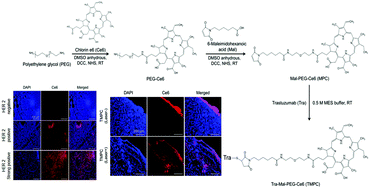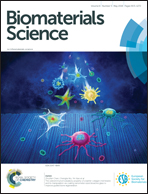Multifunctional trastuzumab–chlorin e6 conjugate for the treatment of HER2-positive human breast cancer†
Abstract
Effective penetration and targeted delivery of anticancer drugs into tumor tissues are limiting factors for achieving enhanced therapeutic efficacy. In order to overcome the disadvantages of antibody therapy (limited penetration efficacy into tumor tissues) and photodynamic therapy (low targeting efficiency) on the treatment of HER2-positive human breast cancer simultaneously, an antibody and photosensitizer combined Trastuzumab–chlorin e6 conjugate (TMPC) was synthesized. TMPC exhibits high singlet oxygen generation under laser irradiation. In vitro data show that TMPC has specific HER2 selective interactions, and ROS generation ability upon laser irradiation induces significant cell death in HER2-positive breast cancer cells. The enhanced tissue penetration ability and tissue access of TMPC resulting from local tissue destruction by ROS generated from Ce6 is also demonstrated in breast cancer tissue blocks. The enhanced ability of TMPC is supported by in vivo fluorescence images of SK-BR-3 (HER2-positive cancer cells) tumor-bearing mice. The in vivo test demonstrates approximately 6-fold enhanced accumulation of TMPC in xenograft tumors with a longer retention time compared to that of the PEG–Ce6 conjugate at 24 h. Thus, trastuzumab and photosensitizer conjugation brings synergistic effects for HER2 selective targeting, where TMPC enhanced tumor tissue penetration improves tumor tissue access and responsiveness of trastuzumab in HER2 overexpressing breast cancer.



 Please wait while we load your content...
Please wait while we load your content...